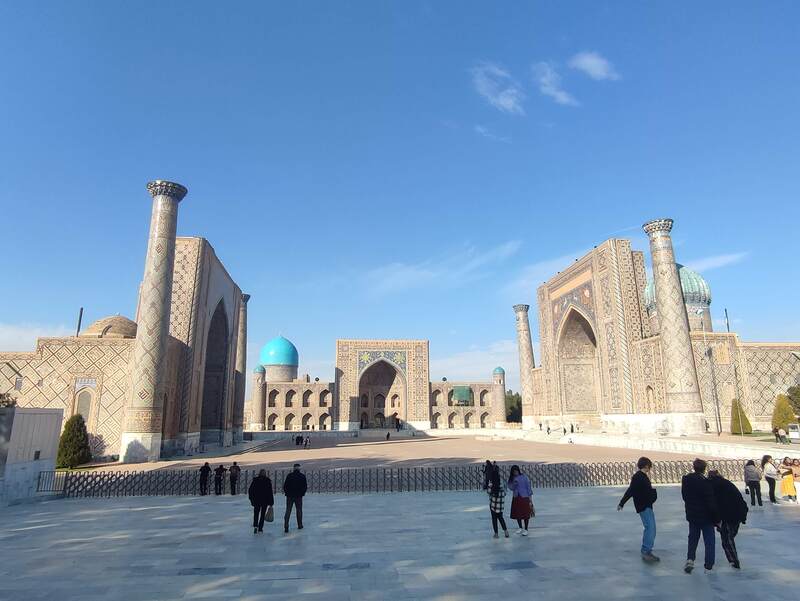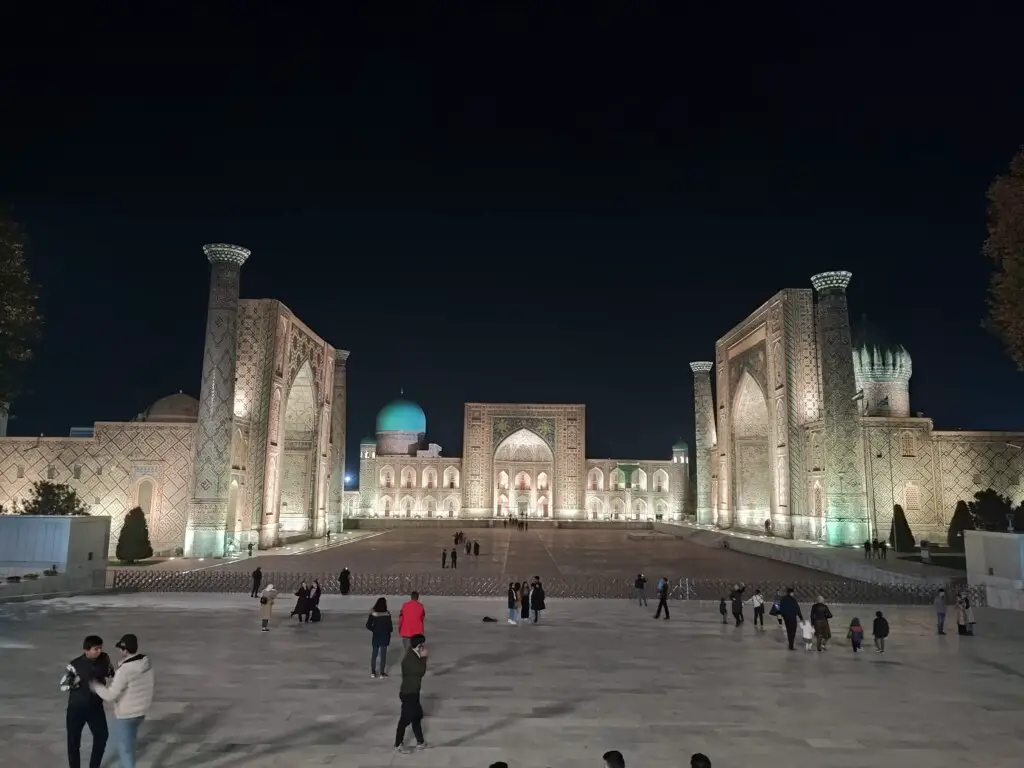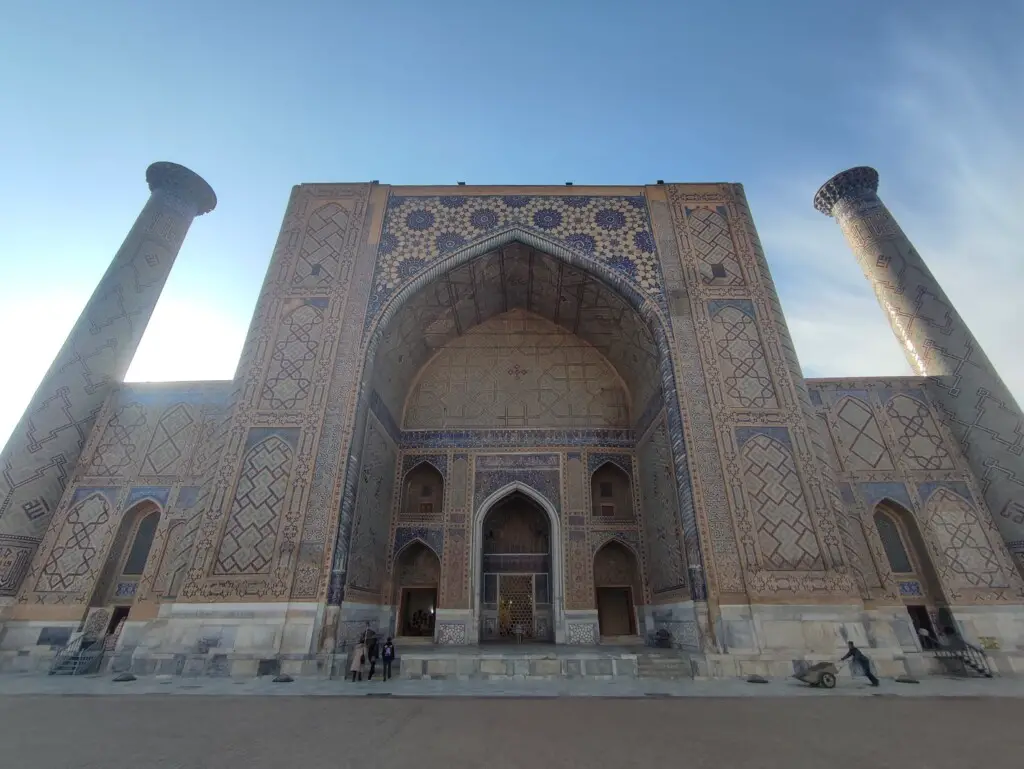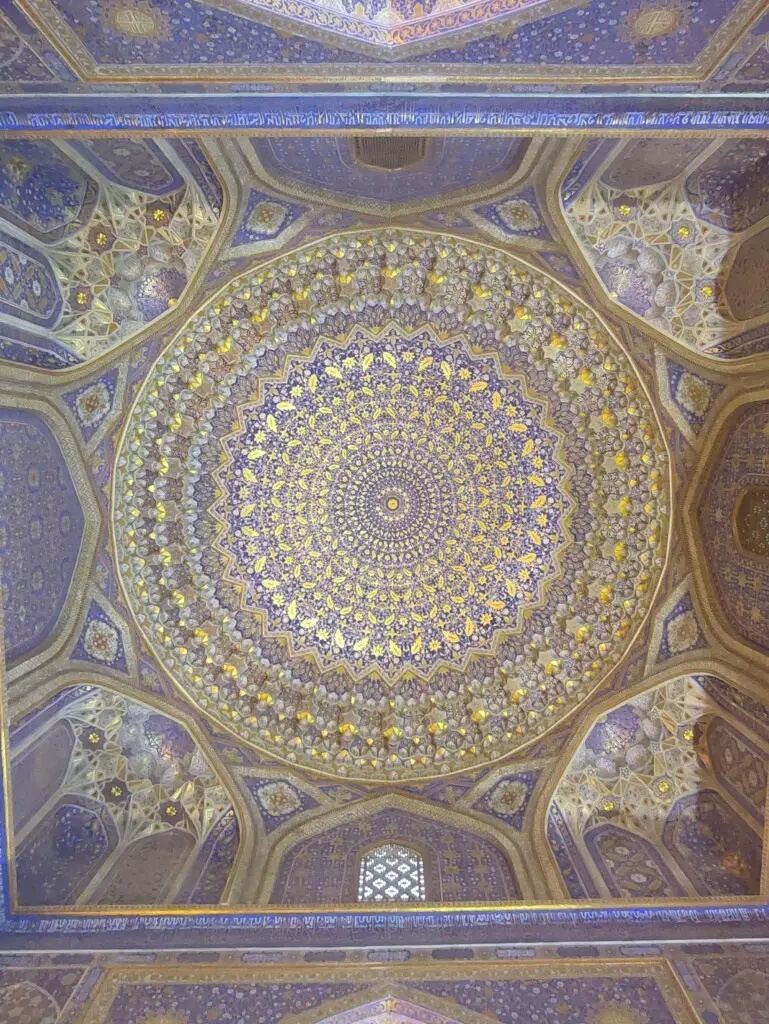Registan Square in Samarkand: A Guide to All Buildings

The Registan Square is located in the heart of Samarkand and is the most recognizable place in all of Uzbekistan. It is a large open square with three impressive madrasahs on the west, north, and east sides of it and is considered the most regal square in the world.
Samarkand is part of the UNESCO World Heritage and its main site – Registan Square is a must-visit for anyone traveling to this ancient Silk Road city.
Overview
The Registan Square (sometimes spelled Registon) has nothing to do with registers. Shallow joke, I know. Registan means “sandy place” (reg=sand, stan=place) in Persian.
Why Persian? Persian was a very significant language in Central Asia in the Middle Ages and during the rise and fall of the Timurid Empire.
The Timurid Empire started with the great Tamerlane (Amir Temur) who made Samarkand his capital city and gave rise to what has been called the Timurid Rennaisance. And this is the reason why Samarkand was so important and why Registan Square is so magnificent.
So does the square have any sand? No, not anymore. But it used to. Between the 15th and the 20th centuries, Registan Square was a place for public executions (among other things like trade and education of course) and the sand acted as a blood absorbent.
Do you want gore?
YES!
Do you want to look at blood?
NO!
Glossary
There are a couple of words about Islamic architecture you should be familiar with in order to make descriptions of Registan Square easier.
| Madrasah | School/college/university (usually religious) |
| Khanqah | A place for Sufi religious gatherings |
| Caravanserai | A roadside inn for travelers and merchants. Very popular on the Silk Road. |
| Pishtaq | A rectangular frame around an arched opening, usually associated with an iwan |
| Iwan | A rectangular hall or space, usually vaulted, walled on three sides, with one end entirely open. The formal gateway to the iwan is called pishtaq |
| Minaret | A tower adjacent to mosques used to project the Muslim call to prayer |
| Hujrah | A room for students / a dormitory inside the madrasah |
| Girih | Islamic geometric patterns of angled lines |
How to visit the Registan Square
Registan Square is in the center of Samarkand. To get to Samarkand from Tashkent, take a train – there is daily service on the bullet Afrosiyob train (2h) as well as the slightly slower one – the Sharq (3:30h).
You can book your ticket online here, though keep in mind the tickets get sold out! In the high season (May-October) I advise you to book 2-3 weeks in advance!
Samarkand is also served by an international airport with direct flights to, among others, Almaty, Istanbul and the recently added Abu Dhabi on WizzAir, the latter costing as low as 30$!
The entrance ticket to the Registan Square is 50000 UZS / 4 USD in 2024.
Madrasahs in Registan Square
Madrasah is an Islamic term that means school or university in English. The translation makes the word lose a bit of its meaning, as is the case with many other Arabic words.
Madrasah is a place for learning, a college of sorts, and can cover any education from elementary to higher, secular or religious.
More often than not though, it refers to Islamic education as is the case with the madrasahs in Registan Square.
The three madrasahs in Registan Square are the Ulugh Beg Madrasah, the Sher-Dor Madrasah, and the Tilya-Kori Madrasah, and were not built at the same time.
Ulugh Beg Madrasah (1417–1420)
The first madrasah in Registon Square was built by, you guessed it, Ulugh Beg, the Timurid Sultan at the time (and an avid astronomer by the way). As you look toward the Square from the viewing platform, the Ulugh Beg Madrasah is on the left.
The iwan is 35 meters high and is covered in intricate geometric patterns with many stars and predominantly in blue. The facade reminds of space and stellar constellations, which is unique, but not surprising, given Ulugh Bek’s passion for astronomy.
The Madrasah itself occupies a rectangular area of 56 x 81 meters, while the courtyard inside is 30 x 40 meters. There are two minarets in the front, restored during the 20th century. The other two at the back did not have the same luck and were lost to the elements.
Inside there are 48 hujrah on two levels. Nowadays the ones on level 1 are occupied by souvenir vendors.
Two more madrasahs in modern Uzbekistan were founded by Ulugh Beg – one in Bukhara and one in G’ijduvon.
Ulugh Beg Madrasah in Samarkand also houses what remains of Ulugh Beg’s Observatory. It was built in 1422, two years after the completion of the madrasah, but unfortunately was destroyed in 1449 and was only discovered in 1908.
See, Ulugh Beg might not have been the most famous leader, commander, or statesman, but he was really, really into astronomy. So much so, that our best star maps after Ptolemy and before Tycho Brahe were indeed created by Ulugh Beg!
There’s a small section about Timurid astronomical achievements inside the Ulugh Beg Madrasah.
Sher-Dor Madrasah (1619–1636)
For almost 2 whole centuries the Ulugh Beg Madrasah stood alone next to Registan Square. Well, not really, as there was also a caravanserai (to accommodate traveling merchants) and a khanqah (for the sufi preachers) nearby.
In the 17th century, both of those buildings were removed to make way for new madrasahs, the first of which was the Sher-Dor Madrasah, which took the place of the khanaq right across Ulugh Beg Madrasah.
Its name literally translates as “having tigers” and you can easily recognize it by the two tigers on both sides of the pishtaq as they are attacking two deers.
That’s extremely unorthodox for Islamic decorations! In Islam, depicting living things is generally forbidden (that’s why most decorations are geometric patterns, stars, and lines).
To add to that, there’s also a sun with a human face in the middle! Now that’s very haram!
So how did the architects and Yalangtush Bakhodur, the ruler of Samarkand at the time reconcile their audacity to mimic reality with their piousness in Islam? Well, with a little loophole, of course.
See, the tigers kind of don’t look like tigers, but a mixture of tigers and lions and a fat pinch of cartoonish features. The creatures, according to official descriptions, are fantastical. As for the face – it has both male and female characteristics, so it “clearly cannot be a real human“. There’s probably a joke to be made here.
Even though the architect of Sher-Dor Madrasah matched the size of the Ulugh Beg Madrasah, it took him 6 times as long – 17 years versus 3 years. On top of that, whereas Ulugh Beg Madrasah has survived almost in its original look, Sher-Dor Madrasah has suffered extensive earthquake damage throughout the ages and was restored twice in 1920 and 1960.
Tilya-Kori Madrasah (1646–1660)
Between the two Madrasahs standing opposite each other in 1636 was the dilapidated Mirzo Caravansarai. Yalangtush Bahadur, the same ruler who ordered the Sher-Dor Madrasah, also ordered the Tilya-Kori Madrasah 10 years later. It took too long to finish for him to see it though – Bahadur died in 1656.
The name literally means “gilded; covered in gold“. The Madrasah was not planned as a replica of the other two, but instead to also be a Juma Mosque – the Friday Prayer mosque, which is usually the main one of a city. The Mosque is still a part of the Madrasah and is richly decorated.
Tilya-Kori Madrasah has the best courtyard if I say so myself. It’s wide, and beautiful, with strong garden vibes. All the facades are covered in geometric patterns, intricate decorations, and beautiful inscriptions.
The yard features one iwan on each side with hujra cells all around: two stories on the main facade side and one story on the rest.
Tilya-Kori Madrasah has also been extensively restored in the 19th and 20th centuries. Today it shines, but it’s suffered a lot of damage from earthquakes. Aptly, it houses the Registan Restoration Museum which gives an overview of the methods employed and a timeline of restoration works.
Other Buildings in Registan Square
Contrary to what your eyes see as you look toward the Square, there aren’t only madrasahs there! Two other prominent buildings in Registan Square are worth mentioning: the Mausoleum of Shaybanids and the Chorsu Trading Dome.
Mausoleum of Shaybanids
Just on the right of Tilya-Kori Madrasah, you will find a row of tombstones that pale in comparison to the grandeur of the main ensemble. Nonetheless, they carry a significant piece of history inside.
The Shaybanids were a dynasty that for a brief period in the 15th and 16th centuries had an empire that ruled over Samarkand, Bukhara, and Khiva. While their empire crumbled, they ruled in isolated pockets (Khiva and Bukhara for example) until the late 17th century.
One of the most prominent leaders of the Shaybanids was Muhammad Shaybani, who formed the Shaybanid Empire in the first place after conquering the Timurid lands from Samarkand to Bukhara and Herat.
His luck ended in 1510 when he was killed in battle by his Saffavid opponents from Iran. His body was buried in Samarkand next to what used to be a khanqah (Sufi hospice) but became the Tilya-Kori Madrasah. Interestingly, his tombstone is all the way in the Ermitage in St. Petersburg.
Chorsu Trading Dome
You can find the Chorsu Dome behind the Sher Dor Madrasah, where once stood the Mirzo Caravansarai of Samarkand. It’s the proof (not like anyone needs any) that Samarkand was an important stop on the Silk Road.
Chorsu means “crossroads” in Persian and is the reason why you will find Chorsu Bazaars in both Tashkent and Margilan.
The Chorsu Trading Dome was built in the 15th century, but what you see today is a restoration from 2005. The market has obviously been moved and you can now find it next to Bibi-Khanym Mosque, some 1km down the road, today called Siab Bazaar.
Inside the Chorsu Dome today you will find an art gallery that showcases the works of Uzbek sculptors and painters.








